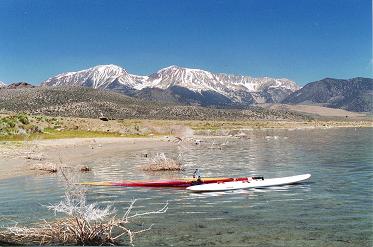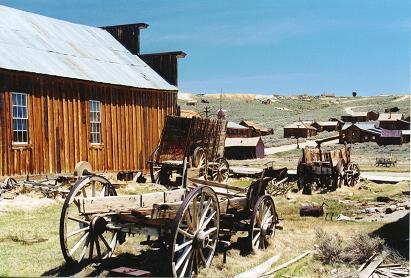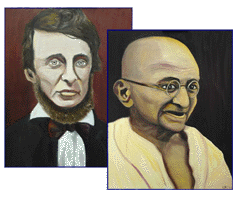"The whole aim of practical politics is to keep the populace alarmed (and hence clamorous to be led to safety) by menacing it with an endless series of hobgoblins, all of them imaginary." ~ H.L. Mencken
Bodie Ghost Town
Hot. Left late in the morning, after hiking around Manzanar "Relocation" Camp. Camped there last night, hoping to hear a ghost but only heard the wind. Slept in my van, along Owens Valley and highway 395. "Your water gone, what's left gives back a muddy azure, like a mildewed mirror," wrote poet BD Love, referring to dried up, lonely places like Manzanar. No lonelier place than the human heart, or the desert devoid of man but the wreckage of his destitution all around.
Hot. So I stopped near Sawmill Creek and hiked up the trail, hoping to find a waterfall or a grove. The Sierra Nevada rose above me and across the narrow valley the dessicated White Mountains looked like a string of bleached bones on a ridgeline. On the way down (never did find that waterfall), I stopped and plunged into the shallow but swift little creek. Floating, I let the rushing water rush through my hair, facing upstream. The feeling made me smile. The awareness I was lolling in LA's drinking water made me smile even more.
This little creek was part of the infamous, much coveted water at the heart of the film "Chinatown." Destined for the lawns, swimming pools, faucets, sprinklers and hoses of the megalopolis of LA, brisk little Sawmill Creek would be captured by the Department of Water & Power of Los Angeles and seen no more. Indeed, most of Owens Valley is like a DWP protectorate.
I headed north the next morning on California's best kept secret scenic route, US Highway 395. The blacktop rose steadily since I left the Salton Sea, now 7,000 feet. Over one pass and down another. The lonely road to lonelier places. Funny, but I always feel loneliest in the city, surrounded by concrete and a million ambitious strangers. Rarely have I felt lonely in the desert; can't explain why.
Deadman's Pass rose to 8,300 feet, a thousand feet higher than the entire chain of Appalachian Mountains. Couldn't believe my van handled the altitude so well. Had to stop and stare at the sign and snap a picture of Tinkerbelle. Then I coasted down into the lakeside village of Lee Vining for breakfast before tossing my sailboard into Mono Lake.
 Almost a million years old, Mono Lake is among the oldest lakes in North America. I could see steam rising from the eastern shoreline as I sailed around the bird sanctuary of Paoha Island. The steam both mystified and frightened me. Any moment I expected a geyser beneath my sailboard, flipping me into boiling water. A week after I left Mono Lake, I read of a minor earthquake there.
Almost a million years old, Mono Lake is among the oldest lakes in North America. I could see steam rising from the eastern shoreline as I sailed around the bird sanctuary of Paoha Island. The steam both mystified and frightened me. Any moment I expected a geyser beneath my sailboard, flipping me into boiling water. A week after I left Mono Lake, I read of a minor earthquake there.
Nearly three times as salty as the ocean, this shallow, alkaline lake is surrounded by a moonscape of bizarre Tufa Towers and a series of extinct volcanos. Tourists come from around the world to snap pictures of the towers and float in the azure waters. Outnumbering the tourists, millions of birds feast on the Mono Lake brine shrimp at the peak of summer. Miniature crustaceans, the brine shrimp number in the trillions at the height of August. Otherwise the lake is completely devoid of fish.
"There's a lot of tragedy in the universe that has missing parts and comes to no conclusion, including probably the tragedy that awaits you and me," wrote Norman MacLean. The time capsule of Bodie vividly epitomizes that observation. Bodie is the best example of an authentic western "ghost town" in America. Treeless, the town appears like a stage set for the Twilight Zone. Set haphazardly at 8,500 feet, the town lived and died in about the same time as allotted to you and I, 70 odd years.
 A gold mining town, an industrial beehive of activity, Bodie once was California's third largest town. Boom and bust, like much of America now and then, Bodie is pure (or impure) Americana, an outdoor morality play, both tragedy and melodrama. 1859-1932, RIP.
A gold mining town, an industrial beehive of activity, Bodie once was California's third largest town. Boom and bust, like much of America now and then, Bodie is pure (or impure) Americana, an outdoor morality play, both tragedy and melodrama. 1859-1932, RIP.
More than 10,000 people lived here once. None now, except for a couple of park rangers. The remaining buildings--only five percent of those that once stood--dessicate in the high desert. More bars than churches, but more good people than bad, I suspect. Now just the relentless summer sun and the winter snow. Thirteen miles from U.S. 395 and quite a climb, as the photo of my van with the Sierra Nevadas mountains in the background, shows.
"Haunted," a woman told me. Her father worked there occasionally, replacing shingles. "People send things back they've taken." I learned that lesson firsthand when I swiped a cold chisel lying in the dirt by the parking lot. Later that afternoon the screws in my camera lens fell out, lost in the dirt of the parking lot. Needless to say, I returned that chisel.
A reputation for corruption, vividly recounted even today, made Bodie a hellhole, according to historians. Bodie lived fast, worked hard, died young. Burnt down twice. But what legacy has Bodie left the world, I wondered? Aside from the fact men will go to the ends of the earth and halfway to hell to extract what is commonly referred to as precious metal, Bodie began the infant labor movement. Miners organized and earned high wages--and lost them in gambling dens, of course, one of which still stands along Main Street, with dusty poker chips and roulette wheel behind the windows.
 A century ago, rowdy miners were arrested along Main Street. Now the entire town of Bodie stands in "arrested decay" (photos). Much is written about the lawlessness of the place, but everywhere I looked I saw industry instead: massive wagons, scattered tools, and the first hydro-electric motor used in western mining.
A century ago, rowdy miners were arrested along Main Street. Now the entire town of Bodie stands in "arrested decay" (photos). Much is written about the lawlessness of the place, but everywhere I looked I saw industry instead: massive wagons, scattered tools, and the first hydro-electric motor used in western mining.
Rambunctious, colorful and industrious, Bodie typified America, then and now. Burn brightly briefly before burning out. Or burning down. The gold ore gone--mostly depleted by 1915--Bodie continued to function on inertia only. Bodies--or Bodie in this case--at rest will remain at rest. Named for Waterman Body, who died in a snowdrift before achieving his fortune, the town remains as moribund as the old Stanley Electric Works motor reposing in the weeds.
Whoever sees the place--Mark Twain, Edward Abbey--wonders long and waxes philosophical. "Bad whiskey, good beer, prostitution, drugs (opium) . . . I am inclined to doubt, however, that this colorfulness was actually particularly enjoyable at the time," wrote Ed Abbey, when he visited Bodie several years ago.
Yet for all the sordid reputation, Bodie hardly seems more notorious than, say, white-marbled Washington DC. Infinitesimal by comparison. Bodie confined her vices and violent crimes to this treeless plateau below the treeline. Bodie cemetery is small compared to the miles of tunnels and the tailing pile of the nearby mine. If the level of violence lived up to the Bodie legend, the cemetery would exceed the score of graves I saw.
Bodie burnt out, burned down, and today lies back of the beyond, thirteen miles off the beaten track. God knows where all that gold went. One hundred million dollars worth and not a gleam to be seen. Unlikely any Bodie ghost knows, or cares, where it all went. Fool's treasure, Abbey called it. Probably somewhere nearer Washington DC, I suspect, than the barren hills of Bodie. Well worth seeing, for what is and isn't there.








 Reprint Rights
Reprint Rights